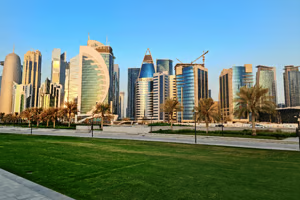Now Reading: Qatar Hits $250M Weekly Real Estate Trade—Big Win Ahead
-
01
Qatar Hits $250M Weekly Real Estate Trade—Big Win Ahead
Qatar Hits $250M Weekly Real Estate Trade—Big Win Ahead

Table of Contents
Real estate trading volume in Qatar reached a staggering QAR 918 million ($252 million) in just one week, according to the Ministry of Justice’s latest real estate bulletin. This sharp surge reflects growing investor confidence and signals a sustained upward trend in Qatar’s property market. With high-value transactions and increasing demand for both residential and commercial spaces, the Qatari real estate sector continues to show strong economic performance.
Strong Week for Real Estate Activity

The real estate trading volume in Qatar for the first week of June 2025 included major deals across Doha, Al Rayyan, Al Wakrah, and other key municipalities. The Ministry reported that most of the trades occurred in residential properties, land plots, and commercial buildings.
This significant real estate trading volume in Qatar shows that the country’s property market remains a solid choice for local and international investors. The data also reflects a healthy demand for infrastructure and long-term assets, especially in areas poised for development.
Breakdown of Weekly Transactions
According to official data:
- Total Value Traded: QAR 918 million ($252 million)
- Top Trading Cities: Doha, Al Rayyan, Al Wakrah
- Primary Assets Traded: Residential homes, land plots, and commercial properties
The report also highlighted a noticeable increase in high-value transactions, including multiple properties exceeding QAR 30 million individually. In total, 79 transactions were recorded across seven municipalities.
Such a high real estate trading volume in Qatar is rare outside of major annual events or project launches, which suggests a more sustainable rise in investment rather than seasonal spikes.
Driving Forces Behind the Boom
Several key factors have contributed to the high real estate trading volume in Qatar this week:
- Government Reforms: Changes in property laws that allow foreigners to own freehold properties have attracted international buyers.
- FIFA Legacy Impact: Post-World Cup infrastructure and tourism boosts have kept Qatar in global investor focus.
- Population Growth: A rising expat and local population has increased demand for housing and commercial space.
- Diversification Strategy: The government’s push to reduce dependence on oil by boosting real estate and tourism sectors is paying off.
Investor Confidence at an All-Time High
Investors see Qatar’s real estate market as a low-risk and high-return environment. The country ranks among the most politically stable in the region, and its economy continues to grow, especially after hosting global events like the FIFA World Cup 2022.
The strong real estate trading volume in Qatar reflects this confidence. Developers are pushing forward with new housing, hospitality, and retail projects, further boosting the sector.
According to industry experts, there has also been an increase in bulk purchases and land banking. This suggests that investors are not just looking for short-term profits but are betting on long-term capital growth.
Spotlight on Doha and Al Rayyan
Doha remains the hub for luxury apartments, commercial towers, and high-net-worth investments. Al Rayyan, on the other hand, has emerged as a hotspot for residential development, offering modern amenities at more affordable prices.
In this week’s report, both Doha and Al Rayyan accounted for nearly 70% of the total real estate trading volume in Qatar, indicating strong momentum in both premium and mid-range segments.
Market Outlook for 2025
With the first half of 2025 showing strong growth, analysts predict the real estate trading volume in Qatar will surpass last year’s numbers. Major projects in Lusail City, The Pearl, and West Bay are progressing steadily and are expected to attract both regional and international investors.
The Qatari government has also announced plans for more smart city developments and green housing, which are likely to draw ESG-conscious buyers. New visa rules for investors and digital property registration platforms have further simplified the buying process.
Experts forecast that if the current weekly average of $250 million continues, Qatar’s annual real estate trade volume could hit $12–13 billion by year-end, a record figure for the nation.
Challenges and Considerations
Despite the positive momentum, there are a few challenges:
- Rising interest rates may impact mortgage uptake, especially among middle-income buyers.
- High-end supply saturation in premium zones could slow price growth.
- Geopolitical factors in the region can influence investor behavior.
However, given Qatar’s fiscal stability and government-backed development plans, these risks are seen as manageable.
What This Means for Buyers and Sellers

For buyers, this is a key moment to enter the Qatari property market. With values steadily climbing and new projects being launched, early investments could yield strong returns.
For sellers, the high real estate trading volume in Qatar means better liquidity and faster closing times. Many brokers report that properties in popular zones are selling within days of listing.
Real estate developers are also offering flexible payment plans and attractive financing options to maintain the current momentum.
Final Thoughts
The real estate trading volume in Qatar crossing $250 million in one week is more than just a headline figure — it’s a strong signal that the country’s property sector is thriving. With robust investor demand, strategic government support, and expanding infrastructure, the Qatari real estate market is on a clear growth path.
As we move further into 2025, all eyes will be on how Qatar leverages this momentum to attract even greater global capital and establish itself as one of the premier real estate markets in the Middle East.
Also Read –Sagittarius Banking Revolution: 5 Ways VeloBank Changes Everything





















